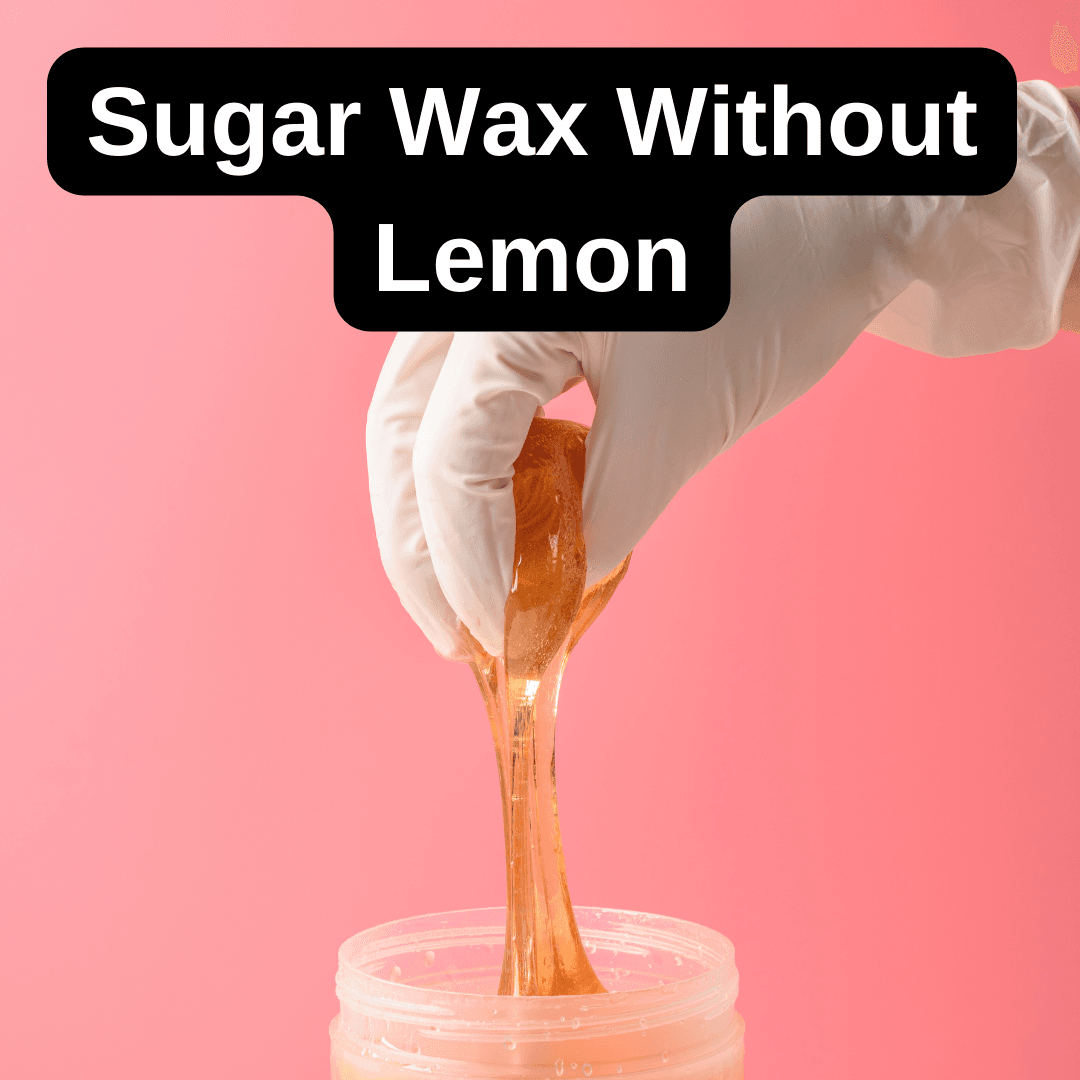Traditional sugar wax recipes often call for lemon juice, but if you’re looking for a no sugar alternative or simply want to avoid lemon, you’re in the right place. Whether you have sensitive skin, a citrus allergy, or just don’t have lemons at home, you can still achieve smooth, long-lasting results with the right ingredients.
In this guide, we’ll show you how to make sugar wax without lemon, using apple cider vinegar, honey, or other substitutes. You’ll also learn the best application techniques, how to avoid common mistakes, and how to achieve salon-quality results—all without lemon juice.
Want to Make Sugar Wax Without Lemon? Here’s How
Most sugar wax recipes include lemon juice because its acidity prevents crystallization and helps maintain the right consistency. However, lemon juice is not essential for an effective wax. Instead, you can use natural alternatives like apple cider vinegar, white vinegar, honey, or orange juice, all of which provide the necessary acidity without affecting the quality of the wax.
This guide will cover:
- How to make sugar wax without lemon juice
- The best substitutes for lemon juice in sugar wax
- Step-by-step instructions for making and applying wax
- Common mistakes and how to fix them
Whether you’re looking for a no sugar alternative or just want to try a new method, this guide will help you achieve the perfect homemade sugar wax.
What is Sugar Waxing?
Sugar waxing, also called sugaring, is an ancient hair removal method that uses a simple blend of sugar, water, and an acidic ingredient. Unlike traditional waxing, sugar wax:
- Is completely natural, without harsh chemicals
- Exfoliates while removing hair, leaving skin soft and smooth
- Reduces ingrown hairs by pulling hair from the root
- Can be used multiple times and is water-soluble
- Is less painful than hot wax because it adheres only to the hair, not the skin
If you’re curious about other waxing methods, check out our guide on laser waxing
Why Avoid Lemon Juice in Sugar Wax?
Lemon juice is typically used in sugar wax to prevent crystallization and ensure the right consistency. However, some people prefer to avoid it for various reasons.
Common Reasons to Avoid Lemon in Sugar Wax
- Sensitive skin: Lemon juice can irritate acne-prone or delicate skin
- Allergies: Some individuals experience citrus allergies
- Drying effect: Lemon juice can strip moisture from dry skin
- Availability: Lemons are not always on hand
The good news is that you can replace lemon juice with other natural alternatives that work just as well.
Best Substitutes for Lemon Juice in Sugar Wax
If you want to make sugar wax without lemon juice, you need an acidic ingredient to maintain the correct texture. Here are the best options:
| H3: Lemon Juice Substitute | Why It Works | Best For |
| Apple Cider Vinegar | Contains acetic acid, prevents crystallization | All skin types |
| White Vinegar | Similar to ACV, milder scent | Oily skin |
| Honey | Acts as a natural humectant, gentle on skin | Dry/sensitive skin |
| Orange Juice | Natural citrus alternative, less acidic than lemon | Normal skin |
| Cream of Tartar | Helps sugar hold structure | Combination skin |
Among these options, apple cider vinegar is the best overall substitute due to its acidity and skin-friendly properties.
How to Make Sugar Wax Without Lemon Juice
If you’re looking for an effective and natural way to remove hair at home without using lemon juice, this DIY sugar wax recipe is perfect. Whether you have sensitive skin, a citrus allergy, or just don’t have lemons on hand, you can still achieve smooth, long-lasting results using simple ingredients.
This detailed step-by-step guide ensures that your sugar wax has the right consistency, spreads easily, and removes hair effectively.
Ingredients
To make sugar wax without lemon juice, you will need:
- 1 cup white sugar (granulated sugar works best for consistency)
- 1/8 cup apple cider vinegar (or substitute with white vinegar, honey, or orange juice)
- 1/8 cup water (filtered water for purity)
Why These Ingredients?
- Sugar acts as the base and creates the sticky wax texture.
- Apple cider vinegar replaces lemon juice, providing the necessary acidity to prevent the sugar from hardening too quickly.
- Water helps dissolve the sugar and ensures the right consistency.
Step-by-Step Instructions

Step 1: Prepare Your Equipment
Before you start, gather:
- A heavy-bottom saucepan (prevents burning)
- A wooden spoon or silicone spatula for stirring
- A candy thermometer (optional but helpful for accuracy)
- A heat-resistant container for storing the wax
Step 2: Mix the Ingredients
- Place the saucepan on the stove and add 1 cup of white sugar, 1/8 cup of apple cider vinegar (or alternative), and 1/8 cup of water.
- Stir everything together before turning on the heat to ensure the sugar dissolves evenly.
Step 3: Heat on Medium and Stir Continuously
- Turn the stove to medium heat and start stirring.
- Keep stirring gently but consistently to prevent the mixture from burning or sticking to the pan.
- As the mixture heats up, you’ll notice small bubbles forming—this is normal.
Do not use high heat, as it can cause the sugar to burn quickly, ruining the wax.
Step 4: Watch for the Color Change

- As the mixture heats, it will go from clear to light golden and eventually to a rich amber or maple syrup color (this takes around 8-12 minutes).
- If using a thermometer, the ideal temperature is 240-250°F (115-121°C)—this is the “soft-ball stage,” where the wax remains flexible.
How to Check Without a Thermometer:
- After about 10 minutes, drop a tiny bit of wax into a cup of cold water.
- If it forms a soft, pliable ball, it’s ready.
- If it dissolves, it needs more time.
- If it hardens immediately, it has been overcooked and needs to be softened with a few drops of water.
Step 5: Remove from Heat and Let it Cool
- Once the wax reaches the correct color and consistency, turn off the heat.
- Pour the wax into a heat-resistant glass or silicone container and let it cool for 30-40 minutes until it reaches a warm, taffy-like consistency.
Important: Do not apply hot wax to your skin—it can cause burns. Always test the temperature before using.
How to Test Sugar Wax Consistency Before Use
Before applying, test a small amount of wax to ensure it’s the right texture:
- If the wax is too runny, it needs more cooling time. Let it sit for another 5-10 minutes.
- If the wax is too hard, reheat it slightly and add a teaspoon of water to soften it.
- If the wax stretches easily and can be rolled into a ball, it’s perfect for use.
How to Store Sugar Wax Properly
- Use an airtight container (a glass jar with a lid works best).
- Keep it at room temperature in a cool, dry place.
- To reuse, warm the wax by microwaving it for 5-10 seconds or placing the jar in warm water for a few minutes.
Pro Tips for the Best Sugar Wax Without Lemon
- Use a non-stick or heavy-bottom saucepan to prevent burning.
- Never leave the mixture unattended—sugar can burn quickly.
- If you accidentally overcook the wax, add a teaspoon of warm water and stir until it softens.
- To make a softer wax for sensitive skin, use honey instead of vinegar.
By following this method, you’ll achieve a perfect homemade sugar wax without lemon that is just as effective as salon treatments!
How to Apply Sugar Wax at Home
Follow these steps for a smooth and effective sugar waxing experience:
- Prepare your skin: Clean and dry the area, removing excess oil or moisture.
- Exfoliate 24 hours before: This helps prevent ingrown hairs.
- Warm the wax: If it’s too hard, microwave for 5-10 seconds.
- Apply in the direction of hair growth: Spread a thin layer using a spatula or fingers.
- Pull in the opposite direction: Remove quickly for best results.
- Repeat if necessary: The same wax ball can be used multiple times before discarding.
After waxing, apply aloe vera or a gentle moisturizer to soothe the skin. For a detailed waxing technique specifically for arms, check out our step-by-step guide on arm waxing.
Common Mistakes & How to Fix Them
| H3: Problem | Cause | Solution |
| Wax is too hard | Overcooked | Add 1 tsp water and reheat |
| Wax is too runny | Underheated | Cook for 1-2 more minutes |
| Doesn’t remove hair | Too cool or thick | Warm slightly before use |
| Causes irritation | Pulled in the wrong direction | Apply correctly, use aloe vera afterward |
When making and using sugar wax, a few common mistakes can occur. Below are the most frequent issues and how to resolve them:
- Wax is too hard: If your sugar wax turns out too hard and difficult to spread, it’s likely that it was overcooked. The best solution is to add one teaspoon of water and gently reheat the mixture until it reaches a more pliable consistency. Be careful not to overheat, as this can cause it to become too runny.
- Wax is too runny: If your sugar wax is too thin or liquid-like, it may not have been heated long enough. To fix this, return it to the stove and cook for an additional 1-2 minutes on low heat until it thickens to the right consistency. Make sure to stir frequently to avoid burning.
- Wax doesn’t remove hair effectively: If your sugar wax is not gripping the hair properly, it could be either too cool or too thick. In this case, warming it slightly before application can improve its effectiveness. You can do this by briefly microwaving the wax for 5-10 seconds or letting it sit at room temperature until it softens enough for use.
- Causes irritation or discomfort: If sugar waxing leaves your skin feeling irritated or overly sensitive, the wax may have been pulled in the wrong direction. To minimize irritation, always apply the wax in the direction of hair growth and pull it off quickly in the opposite direction. After waxing, applying aloe vera gel or a gentle moisturizer can help soothe the skin and reduce redness.
By following these simple fixes, you can ensure that your sugar waxing process is smooth, effective, and comfortable.
If you’re worried about ingrown hairs after waxing, read our in-depth article on how waxing can contribute to ingrown hairs and how to prevent them.
Advantages of Sugar Wax Without Lemon Compared to Traditional Sugar Wax
Many people assume that lemon juice is a necessary ingredient in sugar wax, but using an alternative can offer several benefits. Whether you have sensitive skin, allergies, or simply prefer a gentler option, sugar wax without lemon has unique advantages.
Gentler on Sensitive Skin
Lemon juice is highly acidic, which can cause irritation, redness, or dryness, especially for those with sensitive or acne-prone skin. Apple cider vinegar, white vinegar, or honey are milder alternatives that help maintain the wax’s consistency without the harsh effects of lemon juice.
Reduces the Risk of Skin Dryness
Lemon juice has natural astringent properties, which can strip moisture from the skin. This may lead to excessive dryness, flaking, or irritation after waxing. Using honey or apple cider vinegar as a substitute helps retain skin hydration while still achieving effective hair removal.
Less Risk of Citrus Allergies
Some people experience allergic reactions to citrus fruits, including redness, itching, or rashes. Since sugar wax without lemon eliminates citrus exposure, it is a safer option for those with allergies or sensitivities to lemon juice.
Easier on Sun-Exposed Skin
Lemon juice can increase photosensitivity, making the skin more prone to sunburns and hyperpigmentation after waxing. By avoiding lemon juice in sugar wax, you reduce the risk of skin darkening or irritation caused by UV exposure.
Does Not Require Fresh Lemons
Not everyone has fresh lemons available at home all the time. Substituting vinegar or honey makes the waxing process more convenient, as these ingredients are commonly found in most kitchens and have longer shelf lives than fresh lemons.
Softer and More Flexible Wax Texture
Using honey or apple cider vinegar in sugar wax creates a slightly softer, more pliable texture, making the wax easier to apply and remove. This flexibility helps reduce breakage and ensures a smoother application, especially for beginners.
More Customizable for Different Skin Types
Depending on your skin type, you can choose a substitute that works best for you:
- Dry skin: Honey helps retain moisture and prevents irritation.
- Oily skin: White vinegar provides a lightweight, non-greasy alternative.
- Normal skin: Apple cider vinegar maintains a balanced pH level.
No Sticky Residue or Excessive Crystallization
Some people find that sugar wax made with lemon juice crystallizes more quickly, especially when stored for a long time. Apple cider vinegar and honey-based waxes tend to remain smooth and easy to reheat, preventing excess stickiness or hardening over time.
Less Harsh Smell During Cooking
Lemon juice can produce a strong, sometimes overpowering smell when heated with sugar. Vinegar-based sugar waxes have a milder scent, while honey-based alternatives offer a naturally pleasant aroma.
Just as Effective as Traditional Sugar Wax
Despite lacking lemon juice, sugar wax made with vinegar or honey works just as well in removing hair from the root, providing long-lasting smoothness and reducing hair regrowth over time.
FAQs About Sugar Waxing Without Lemon
Can I make sugar wax without lemon?
Yes! You can replace lemon juice with apple cider vinegar, white vinegar, honey, or even orange juice. These alternatives provide the necessary acidity to prevent sugar crystallization and improve wax consistency.
Is lemon necessary for sugar wax?
No, lemon juice is not necessary. While it helps stabilize the wax, many alternatives work just as well, such as vinegar or honey.
How to make sugar wax with only 3 ingredients?
A simple sugar wax recipe includes:
• 1 cup sugar
• 1/8 cup water
• 1/8 cup apple cider vinegar (or another substitute)
Cook until golden brown, let it cool, and apply as needed.
Can I use only sugar for wax?
No, sugar alone won’t work because you need a liquid ingredient to dissolve it and create the right consistency. A small amount of water and acid (like vinegar or honey) is necessary to make the perfect sugar wax.
What is the best alternative to lemon juice in sugar wax?
The best alternative depends on your skin type and preference.
• Apple cider vinegar: Best overall replacement, maintains proper texture
• White vinegar: Works similarly to apple cider vinegar but has a milder scent
• Honey: Moisturizing and gentle on sensitive skin
• Orange juice: A mild citrus alternative for those who still want a natural acid
Among these options, apple cider vinegar is the most effective alternative due to its acidity and skin-friendly properties.
For those exploring natural alternatives like sugar waxing, this detailed guide explains how it compares to using an epilator.
Can I use just sugar and water to make wax?
No, sugar and water alone will not work because there is no acidic component to prevent crystallization. Without an acid, the sugar will harden too quickly, making it impossible to spread on the skin.
How do I prevent my sugar wax from getting too hard without lemon juice?
If your sugar wax hardens too quickly, try these fixes:
• Use a lower heat setting while cooking to prevent over-thickening
• Add one teaspoon of water and reheat if the wax is too hard
• Use honey as a substitute to create a softer, more pliable wax
Can I use sugar wax without lemon on all parts of my body?
Yes, sugar wax without lemon can be used on all areas where traditional sugar wax is applied, including arms, legs, the bikini area, underarms, and the face (upper lip, chin). Avoid using it near the eyes or on very sensitive areas without testing first.
Will sugar wax without lemon turn into candy?
If the wax is cooked too long or at too high a temperature, it can harden into a candy-like texture. To prevent this:
• Use a thermometer and remove from heat at 230–240°F (110–115°C)
• Add a few drops of water and reheat if it becomes too thick
Can I make sugar wax without lemon and vinegar?
Yes. If you want to avoid both lemon juice and vinegar, you can use:
• Honey, which acts as both the liquid and acidic component
• Orange juice, a mild citrus alternative
• Cream of tartar, which works similarly to vinegar in preventing sugar from hardening too quickly
What happens if my sugar wax without lemon is too grainy?
If your sugar wax turns grainy, it has started to crystallize. To fix it:
• Reheat it gently on low heat while stirring
• Add one teaspoon of water and mix well
• Use apple cider vinegar instead of white vinegar for a smoother consistency
Why does my sugar wax without lemon keep breaking?
If the wax breaks apart instead of stretching, it is likely too dry or overcooked. To fix this:
• Add one teaspoon of warm water and stir until it softens
• Warm it slightly in the microwave before using
Can I make sugar wax without lemon using just honey?
Yes. Honey can act as both the liquid and acidic component, making it a great substitute. Honey-based sugar wax tends to be softer and more hydrating for the skin, but it may need longer cooking time to reach the right consistency.
Should I add more water to sugar wax if I don’t use lemon?
No, do not add extra water to compensate for the lack of lemon juice. Instead, use an acid like vinegar or honey to maintain the correct consistency. Adding too much water will make the wax too runny.
How do I store sugar wax without lemon juice?
• Keep in an airtight container at room temperature
• Avoid moisture exposure, which can cause crystallization
• Warm slightly before use if it becomes too firm
Does sugar wax without lemon smell different?
Yes, depending on the substitute used. Apple cider vinegar or white vinegar may give the wax a slightly sour scent, but this usually fades once applied. Honey-based sugar wax has a naturally sweet smell.
Is “sugar wax no lemon” better for sensitive skin?
It can be. Lemon juice can be drying and irritating for some people, so switching to honey or vinegar-based sugar wax may reduce redness and sensitivity.
Will Sugar Wax Without Lemon Last as Long?
Yes, sugar wax made without lemon juice lasts just as long as regular sugar wax. When stored properly in an airtight container at room temperature, it remains usable for up to three months. If it hardens, simply warm it slightly to bring back its original consistency.
What Is the Best Alternative to Lemon Juice in Sugar Wax?
The best alternative depends on your skin type:
• Apple cider vinegar – Best overall substitute, balances pH
• Honey – Ideal for dry and sensitive skin, adds moisture
• White vinegar – Works well for oily or combination skin
• Orange juice – A mild citrus alternative for normal skin
Can I Use Just Sugar and Water for Wax?
No, sugar and water alone will not work because they lack acidity. Without an acid like lemon juice, vinegar, or honey, the sugar will crystallize too quickly and become too hard to use as wax.
Does Sugar Wax Without Lemon Smell Different?
Yes, depending on the substitute used.
• Apple cider vinegar or white vinegar may give the wax a slightly sour scent, but this usually fades after application.
• Honey-based sugar wax has a naturally pleasant, sweet aroma.
Will Sugar Wax Without Lemon Cause More Irritation?
No, in fact, it may cause less irritation than lemon-based sugar wax. Lemon juice is highly acidic, which can be too harsh for some skin types. Vinegar-based or honey-based sugar waxes tend to be gentler and more hydrating.
Is Sugar Wax Without Lemon Worth Trying?
Absolutely! If you have sensitive skin, allergies, or simply don’t have lemons at home, making sugar wax without lemon juice is a great alternative. By using apple cider vinegar or honey, you can achieve salon-quality results from the comfort of your home.
This DIY sugar waxing method is:
- Affordable – Costs less than a dollar to make
- Eco-Friendly – No plastic waste or harmful chemicals
- Effective – Removes hair from the root for long-lasting smoothness
Now that you know how to make sugar wax without lemon, it’s time to try it yourself! Let us know how it works for you in the comments.

Meet the Epilation World Expert Team
Our team consists of certified professionals with over 17 years of experience in laser hair removal, skincare, and personal care. With advanced training in diode laser, IPL, waxing, and skin health, we combine clinical precision with real-world expertise to deliver reliable, evidence-based guidance.
Every article is carefully created and reviewed by our experts to ensure safety, clarity, and scientific accuracy. Our work has helped thousands choose safe, effective hair removal solutions tailored to their unique needs.
Trusted expertise. Real results. That’s our promise.





